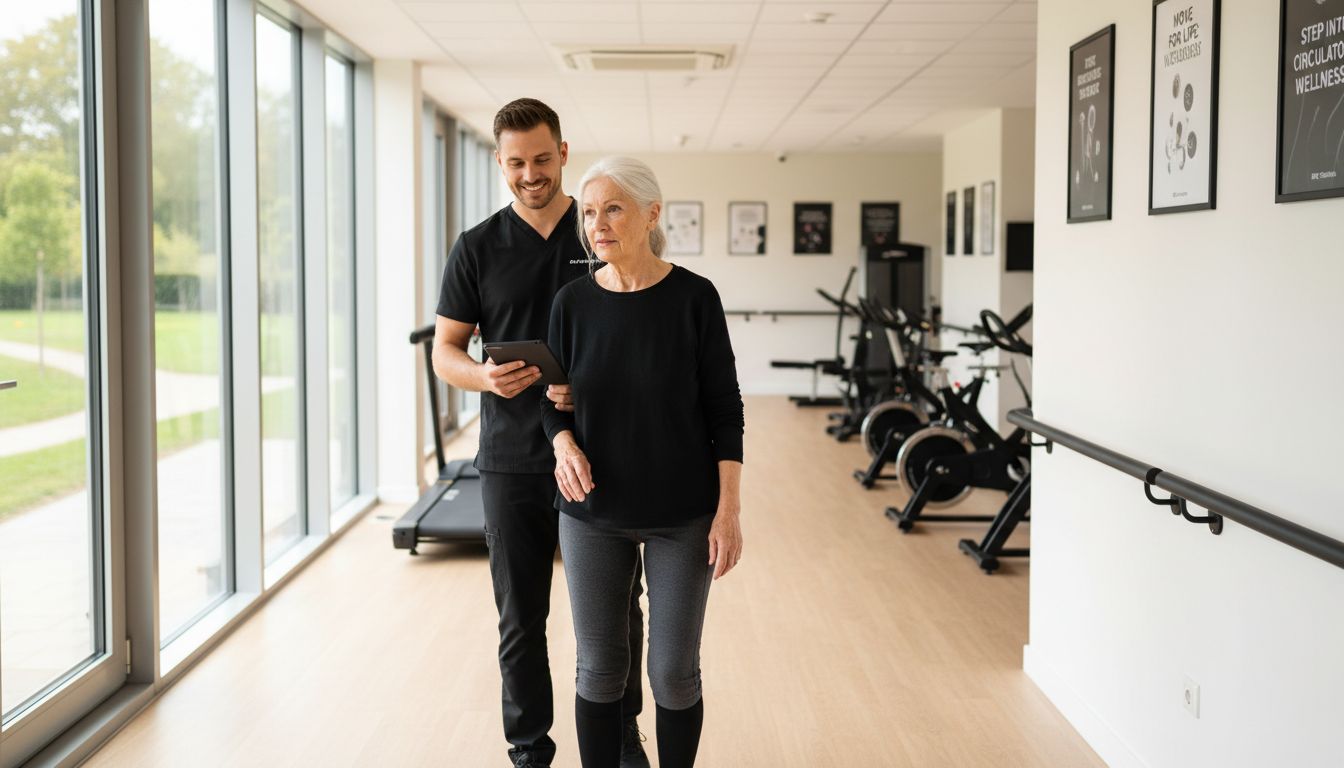
Benefits of Outdoor Walks: Complete Expert Guide
Share
Did you know that just thirty minutes of brisk walking every day can decrease your risk of heart disease by nearly thirty percent? Outdoor walks offer more than simple exercise—they deliver a full spectrum of health advantages for body and mind. From improving blood circulation and building muscle strength to reducing stress and sharpening mental focus, this natural activity stands out as a straightforward way to gain long-term wellness benefits.
Table of Contents
- Understanding Outdoor Walks For Health
- Physical Benefits For Circulation And Veins
- Mental Well-Being And Stress Relief
- Safety Tips For Individuals With Circulatory Issues
- Integrating Walks With Compression Therapy
Key Takeaways
| Point | Details |
|---|---|
| Health Benefits of Walking | Walking is a low-impact exercise that reduces the risk of chronic diseases such as heart disease and diabetes while enhancing bone strength and muscle endurance. |
| Mental Health Advantages | Regular outdoor walking improves mood, reduces stress and anxiety, and enhances cognitive function through the release of endorphins. |
| Circulatory Improvements | Walking significantly boosts circulation and vascular health, aiding in reduced blood pressure and improved heart function. |
| Safety Precautions | Individuals with circulatory issues should consult a healthcare provider, start with low-intensity walks, stay hydrated, and consider using compression stockings for better support. |
Understanding Outdoor Walks for Health
Walking represents one of the most accessible and powerful forms of exercise available to humans - a natural movement that requires zero equipment and delivers remarkable health benefits. According to research from Harvard Health, walking is a simple, free, and low-impact activity that can dramatically reduce risks of serious chronic conditions like heart disease, diabetes, and certain cancers.
As a weight-bearing exercise, walking provides multiple physiological advantages. According to University of Cumberlands research, regular walking enhances bone strength, reduces body fat, increases muscle strength, and helps manage critical health markers including high blood pressure, diabetes, and cholesterol levels. The beauty of walking lies in its simplicity - you can start at any fitness level and progressively improve your overall health.
The mental health benefits are equally compelling. Walking stimulates the release of endorphins, natural mood-boosting chemicals that help reduce stress, combat anxiety, and improve overall cognitive function. For individuals managing circulatory conditions or seeking gentle exercise, walking for circulation guide can offer targeted insights into maximizing health benefits.
Key health advantages of consistent outdoor walking include:
- Improved cardiovascular fitness
- Enhanced muscular endurance
- Better joint mobility
- Reduced risk of chronic disease
- Natural stress reduction
- Increased mental clarity and emotional well-being
Physical Benefits for Circulation and Veins
Outdoor walking offers powerful advantages for vascular health, particularly in supporting and improving circulation throughout the body. Research demonstrates that consistent walking can dramatically transform cardiovascular function. According to a study published in PubMed, regular participation in walking groups leads to significant reductions in systolic and diastolic blood pressure, resting heart rate, and total cholesterol levels.
For individuals concerned with heart health, walking emerges as a natural and effective intervention. A comprehensive research analysis from Le Monde reveals that brisk walking can reduce the risk of atrial fibrillation by up to 46%. This simple activity also provides remarkable metabolic benefits, including improved lipid profiles, enhanced blood sugar regulation, and decreased systemic inflammation.
Circulatory benefits extend beyond cardiovascular improvements. Walking stimulates blood flow, helps prevent blood pooling in lower extremities, and supports overall vascular elasticity. For those managing venous conditions or seeking to understand improving circulation naturally, walking represents a foundational strategy for maintaining healthy blood vessels.
Key physical benefits for circulation include:
Here’s a summary comparing the key benefits of outdoor walking by health focus:
| Health Focus | Physical Benefits | Mental Benefits | Recommended Strategies |
|---|---|---|---|
| Circulation & Veins | Enhances blood flow Lowers blood pressure Improves vessel flexibility |
Reduces stress hormones Boosts endorphins |
Use compression stockings Stay hydrated |
| Mental Well-Being | Supports healthy heart rhythm Reduces inflammation |
Less anxiety Improved sleep Emotional balance |
Walk in nature Practice mindfulness |
| Weight Management | Increases muscle strength Burns fat |
Boosts self-esteem Sharpens focus |
Walk daily Progress intensity |
- Enhanced blood vessel flexibility
- Reduced risk of blood clots
- Improved oxygen delivery to tissues
- Better metabolic waste removal
- Lower inflammation markers
- Stronger cardiovascular resilience
Mental Well-Being and Stress Relief
Outdoor walking is a powerful antidote to modern stress, offering a natural and accessible method for improving mental health. According to research published in Time magazine, spending just 15 minutes in nature can significantly increase happiness and reduce psychological stress, providing an immediate boost to overall emotional well-being.
The rhythmic movement of walking triggers a cascade of positive neurochemical responses in the brain. As you walk, your body releases endorphins and serotonin, neurotransmitters responsible for creating feelings of happiness and reducing anxiety. This natural mood enhancement occurs without the need for medication, making walking an empowering approach to mental health management.
For individuals seeking holistic stress management strategies, walking offers more than just chemical benefits. It provides a meditative space for reflection, helps break negative thought patterns, and creates mental distance from daily pressures. Those interested in comprehensive stress management might find additional insights in our breathing exercises for stress relief guide, which complements walking’s mental health benefits.
Key mental health advantages of regular walking include:
- Reduced anxiety and depression symptoms
- Improved emotional resilience
- Enhanced cognitive function
- Better sleep quality
- Increased mindfulness
- Natural stress hormone regulation
Safety Tips for Individuals With Circulatory Issues
Individuals with circulatory challenges can still enjoy the benefits of walking by implementing strategic safety measures. Research from Harvard Health highlights that participating in walking groups yields significant health improvements, including enhanced blood pressure regulation, reduced resting heart rate, and better overall physical functioning.
A critical strategy for those managing circulatory conditions is combining walking with targeted support. According to a PubMed study, using compression stockings during late afternoon walks can effectively reduce leg edema and improve circulation. How to boost leg circulation becomes particularly important for individuals seeking to maintain vascular health while minimizing potential risks.
Before beginning any walking routine, individuals with circulatory issues should consult their healthcare provider to develop a personalized approach. Key safety considerations include starting with short, gentle walks, monitoring body response, staying hydrated, and wearing appropriate supportive footwear and compression garments.

Essential safety recommendations for walking with circulatory challenges include:
- Start with short, low-intensity walking sessions
- Use compression stockings during walks
- Stay well-hydrated
- Monitor your body’s response and fatigue levels
- Wear supportive, comfortable footwear
- Walk on even, predictable surfaces
- Avoid extreme temperatures
- Listen to your body and rest when needed
Integrating Walks With Compression Therapy
Compression therapy and walking form a powerful synergy for individuals seeking to improve circulatory health. Research from PubMed demonstrates that combining compression stockings with walking, particularly in the late afternoon, can effectively reduce leg edema and enhance overall vascular function.
The strategic use of compression garments during walking provides multiple physiological benefits. These specialized stockings apply graduated pressure to the legs, promoting blood flow from the extremities back to the heart, reducing swelling, and minimizing the risk of blood pooling. Compression socks for walking offer targeted support that can transform a simple walk into a therapeutic circulation-boosting activity.
To maximize the benefits of compression therapy during walking, it’s essential to select the right compression level and fit. Individuals should consult healthcare professionals to determine the most appropriate gradient of compression based on their specific circulatory needs. Proper wear techniques, such as putting on stockings before walking and ensuring smooth, wrinkle-free application, can significantly enhance therapeutic outcomes.
Key strategies for integrating walks with compression therapy include:
- Choose compression stockings with appropriate pressure gradient
- Put on stockings before starting your walk
- Start with shorter walking sessions
- Gradually increase walking duration and intensity
- Stay hydrated during and after walks
- Monitor leg comfort and response
- Consult healthcare provider for personalized guidance
- Replace compression garments regularly
Enhance Your Outdoor Walks with Expert Compression Solutions
If you find yourself struggling with leg discomfort, swelling, or poor circulation during or after your outdoor walks this expert guide helps you understand why combining walking with medical-grade compression stockings can make all the difference. The article highlights how walking supports vascular health by improving blood flow and reducing inflammation but also stresses the importance of safety and support for individuals with circulatory issues. Walking while wearing properly fitted compression stockings from trusted brands like Jobst can boost your results by promoting vessel flexibility, reducing leg edema, and enhancing overall comfort.
Take charge of your leg health today by exploring our carefully curated selection at Fit Stockings where you can find a range of styles and compression levels tailored to your needs. Discover practical advice and product options to complement your walking routine in our helpful blog posts like how to boost leg circulation and learn why compression socks for walking are a must-have for lasting comfort and improved circulation. Don’t let discomfort hold you back from reaping the powerful benefits of outdoor walks start your journey towards healthier legs today at Fit Stockings.
Frequently Asked Questions
What are the health benefits of outdoor walking?
Walking outdoors improves cardiovascular fitness, enhances muscular endurance, boosts joint mobility, reduces the risk of chronic diseases, and promotes natural stress relief. It also increases mental clarity and emotional well-being.
How does walking help improve circulation?
Walking enhances blood flow, lowers blood pressure, improves vessel flexibility, and helps prevent blood pooling in lower extremities. Regular walking can also lead to better metabolic waste removal and stronger cardiovascular resilience.
Can walking improve mental health?
Yes, walking stimulates the release of endorphins and serotonin, which are natural mood boosters. This activity reduces anxiety, enhances emotional resilience, and can improve sleep quality and cognitive function.
What safety tips should I follow while walking if I have circulatory issues?
Start with short, low-intensity walks, use compression stockings during walks, stay hydrated, and wear supportive footwear. It’s also essential to consult your healthcare provider for personalized recommendations.

